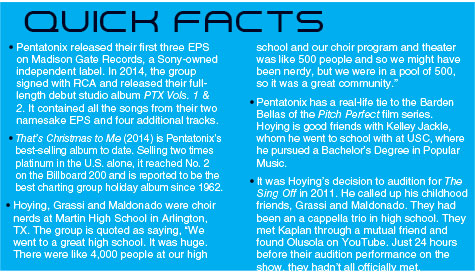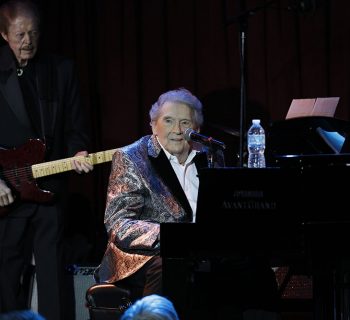Extending the whirlwind of seemingly non-stop recording, video and touring activity that has catapulted Pentatonix from third season winners of NBC’s The Singoff in 2011 to multiplatinum selling global superstars, the five-piece, three-time Grammy-winning a cappella group returns to its trademark, PTX-izing classic and contemporary pop favorites on its new full-length album PTX Presents: Top Pop, Vol. 1.
After spending much of the past two years on the road with their Pentatonix World Tour with legs in Europe, Asia, Oceania and North America, and a six city holiday tour last December, Pentatonix is gearing up to play larger arenas on their 39 date North American tour produced by Live Nation, beginning in Salt Lake City on July 12.
Considering how common it is for winners of TV talent contests to create a quick buzz and fade to obscurity, Pentatonix’s massive success and ongoing upward trajectory are nothing short of staggering. The group––Arlington, TX high school friends Scott Hoying, Mitch Grassi and Kirstie Maldonado (lead vocalists), beatboxer Kevin “K.O.” Olusola and the newest member, bass vocalist Matt Sallee––has sold nearly 10 million albums worldwide and performed for hundreds of thousands of fans across the globe.
Their YouTube Channel boasts more than 15 million subscribers, yielding over 3.1 billion video views. As of early April, the clip for “Havana” had received 17 million views and “Attention” had earned 7.1 million views. Two of their albums, a self-titled release in 2015, and A Pentatonix Christmas (2016) hit No. 1 on the Billboard 200, five of their singles went gold (including “Radioactive” and “Daft Punk”) and two (“Hallelujah” and “Mary, Did You Know?”) went platinum. “Hallelujah” is their all-time most popular video, with 296 million views. The group has had two holiday specials on NBC, released a tour documentary (On My Way Home) in 2015 and appeared in the feature film Pitch Perfect 2.
Last year marked a major transition for Pentatonix with the departure of original bass vocalist (and longtime fan favorite) Avi Kaplan, who left because of his increasing difficulty in keeping up with the touring demands of the group and the resulting distance from his friends and family. His last performance with the group was at the end of their tour in September 2017. Sallee officially replaced him the following month.
A week before the release of their new album, Hoying and Grassi hopped on a conference call, eager to talk about how Sallee is fitting in with the four veteran members, and their decision to return, at least temporarily, to creating fresh arrangements of songs everybody knows and loves.
Music Connection: Congratulations on the album and the singles and videos for “Havana,” “New Rules x Are You That Somebody” and “Attention.” Tell me about those tracks. Let’s start with “Havana.” Why was that the perfect single to introduce your new album PTX Presents Top Pop, Vol. 1?
Scott Hoying: “Havana” was one of the biggest pop songs of the last year, and we were all unanimously obsessed with it. Once we heard it, it was always one that we were going to cover. This is a song that stood out as naturally as adaptable to our sound as any song we have ever done. Once we started working on it, it was clear to us that it was tailor made for PTX and it was like a lot of big planets aligned for it to be released. It’s one of our favorite arrangements that we have ever done, and a huge hit, so that’s a powerful combination.
MC: The mashup of “New Rules x Are You That Somebody?” is unique in that it blends a pop hit from this past year with a 20-year-old song by Aaliyah. Who came up with that idea? Why did you think the songs would mash so well?

Mitch Grassi: Without us even knowing, Kevin, our resident beat box genius, posted a video of himself mashing them up. Scott was a big fan of “New Rules” already, so when he saw Kevin post that clip mashing it up with Aaliyah, it didn’t take long to make it a full-blown PTX arrangement. The Aaliyah song has that iconic bassline and, honestly, a lot of contemporary songs could flow perfectly over it. “New Rules” was one of those natural fits. It mashed up well, and it was cool to give love to two great female pop stars from different eras.
MC: How about “Attention”?
Grassi: Just like “Havana,” it was another perfect song for a PTX arrangement and one of our strongest. We’re huge fans of it.
Hoying: When we got the mix back on that one, it had so much energy. Like Mitch says, we liked it, but we didn’t expect that it would become one of our favorites. It was so much fun to arrange and record. We arranged at least 10 other songs before we decided to pick that one.
Grassi: So much energy, and the result is awesome and essential PTX. We had some different considerations with having a new member, but the key to making this album work was going back to our roots and doing covers of recognizable songs that fit in with our style. Our fans really missed the covers.
MC: That brings us to the new album. What is the concept behind it and how do you think it reflects where the group is right now?
Grassi: We’ve got Matt now and so the concept was sort of a re-introduction to the group. We started out and became famous for doing cover after cover, and people really like that. It made sense to get back to what we consider “essential Pentatonix” as the best way to introduce our amazing new bass.
Hoying: Like Mitch said, people just love our covers and, honestly, we missed doing them. The reaction to them in the past has been so warm, with everyone sharing and becoming obsessed and waiting to hear what we would tackle next. Going back to that was a blast. There are several different considerations in deciding what we want to cover. It boils down to one or more of us hearing a song on the radio and imagining in our heads doing it a different way that’s interesting and compelling. I think what excites longtime fans and people who are new to what we do is that we can emulate these songs with just our voices. The original tracks they’ve heard over and over on the radio, TV and YouTube usually have a full band and/or a synthesizer and major production, and here we are using just five voices but making it just as fun and interesting.
MC: How did you choose the material? Is it a democratic process?
Hoying: We went through the biggest hits of the past year to find songs we felt we could do well, tunes with beautiful chords and melodies for starters. We only have our voices to depend on, so the songs we perform have to be really good and have strong identifiable elements. Any song can be a big hit because of its production, but it’s what’s beneath the production that we focus on.
We also gravitate to songs with rhythmic patterns we think Kevin can kill with his beatboxing. Besides the lead vocal, we only have that, a bassline and two background parts. We have to make sure that all of these elements can create the production behind the lead vocal.
It’s a process of whittling down. The album has 10 or 11 songs, and we maybe started with 40, cutting them one by one down to that smaller number to start arranging. We have done this so many times that we instinctively know what songs will work for us.
Grassi: It’s a very democratic process. We know by now not to let our egos get in the way of our collaborations. When we throw out ideas for solos, for example, we know exactly who is best suited for each solo line, so there’s no argument. We put the music first. Our focus is always on making the music the star and making each track the best we’ve ever done.
Hoying: Of course, we’re gonna nitpick this and that and worry about and fine tune the little details, but ultimately the song is bigger than we are. We see each song as an emotional bridge that moves people and helps them connect with what we are doing. We always have productive conversations about every song we arrange. The vibe we have created is peaceful and we are able to discuss things calmly. It’s a healthy process.
MC: Does the subtitle Vol. 1 mean it’s the first of a series? What is the overall game plan for the material and release schedule if so?
Hoying: It’s the beginning of a larger thing, for sure. We plan on doing more albums like this and then hopefully expand to other genres. But for now we’re living and working in the moment, focusing on these songs, our catalog of hits and the upcoming tour. We have not decided just what the future will be, but rest assured, we will continue to make the music we love.
Grassi: The title feels pretty straightforward. We’re excited to do all these covers and people out there are telling us that they’re excited, too. The title is our way of saying, hey, more is coming, but for now, we know you’re gonna love these!
MC: This is your first recording since the departure of original member Avi Kaplan. How did his leaving affect the band emotionally and creatively?
Hoying: His leaving was an insanely emotional time that helped us grow together and become an even stronger family. It was hard because we were all together, for what seemed like every second, for five years. He decided to leave because our schedule is intense and he was not happy with the group lifestyle. We knew that for a while, but he graciously stuck with it and wanted to be there for the group to keep us in a strong place and help us continue our momentum. But at some point he had to make a major decision. I think Avi just wanted to have a normal life, get a house and not be on the road all the time. He’s a big family guy and he made the best decision for himself. As for us, we worried about our own mental and creative health and how we would survive the transition.
We had this fear that the group might fall apart. I mean, the way we all first came together on the show and the chemistry flowed so naturally from our very first rehearsal. That had never been done before, and we had this paranoia that we would never reach that incredible place and feeling again. To find a replacement, we went through 40 to 50 videos of bass vocalists, all along wondering if anyone would be as good as Avi and have a personality as amazing as his. We had a lot of different boxes to check.
 Grassi: It was a really tough time. There’s never been a group out there that is exactly like us, and our task was to find someone who had a lot of touring experience, who was an incredible bass singer, who looked good with the band, fit in aesthetically and had the right attitude so that we could continue to work in this safe, comfortable creative space. Of those 50 videos, we brought in eight to audition with us, then narrowed it to three. When Matt came in, he knew and killed every song. He had really studied our material and arrangements.
Grassi: It was a really tough time. There’s never been a group out there that is exactly like us, and our task was to find someone who had a lot of touring experience, who was an incredible bass singer, who looked good with the band, fit in aesthetically and had the right attitude so that we could continue to work in this safe, comfortable creative space. Of those 50 videos, we brought in eight to audition with us, then narrowed it to three. When Matt came in, he knew and killed every song. He had really studied our material and arrangements.
MC: What is Matt’s background, how did you find him and what made him the right choice?
Grassi: We knew that he had gone to Berklee College of Music and performed both as a solo artist and as a member of one of the country’s best collegiate a cappella groups, Pitch Slapped. He has also been on stage with Jessie J and Jill Scott. So definitely a great resume. We had a lot of time to search because Avi gave us a heads-up and we took every precaution to make sure we found the right guy. We’re used to quick turnarounds and work best under pressure.
Hoying: We actually hired someone to find basses for us and Ben Bram, our longtime arranger, producer and sound engineer, sent Matt’s video to us. He came to the audition dancing and smiling and had great energy. The room just lit up in his presence and we could all feel it. That was it more than anything else. All of the finalists had great technical skill, but Matt made us feel good. And after all, that’s what PTX is all about, making people feel good.
MC: Was there an instant chemistry with Matt or was there a process of adjustment? What do you think he brings to the band that’s unique yet keeps the flow seamless?
Grassi: It was surprisingly easy, actually. Not only did he fit in perfectly, but he works so hard and is always prepared to get to work. We were also pleased that our fan base embraced him immediately. We miss Avi and love Matt. But there was concern because Avi was very beloved, and we were so stressed out that our fans might go, ‘I don’t like it anymore.’
Hoying: Matt also brings a sense of youthfulness to the group. His life goal was to be in a big a cappella group, and it’s exciting to realize that we are making his dreams come true. He brings gratitude and excitement to everything. We’re touring six months a year and still love it, but the rest of us are in more of a chill mode. It’s a bit nostalgic for us to remember how we were a few years ago when all this was new. So combining that with the fresh energy and it’s so insanely valuable––and unexpected.
MC: Your 2015 full-length self-titled album included a lot of originals. Why haven’t you recorded more original material?
Hoying: We’re really trying to switch it up. Doing the album of originals was a long, beautiful but grueling process. We can do covers in two seconds, and it’s a little more fun for us to return to that vibe, at least for the moment. We like our original stuff and the album did well, so we’re definitely going to go back to writing originals at some point. But because it was so much more work we took a long break from that and it seemed more effortless to get back to making music doing the covers.
Grassi: Our intense fans love our original songs, but doing those is quite a daunting task. I don’t think we’re giving up on them, but recording covers is a more surefire way to get back to what we do best.
Hoying: I can see some skeptics thinking going back to covers is like, “Retreat, retreat, no more originals,” but that was a gold album and “Can’t Sleep Love” was a gold single, so it’s clear that people respond to that side of our artistry as well. The challenge in doing original songs is that we have five people with different tastes to curate and write the songs, and there’s a lot of push and pull. Those different tastes come together much more efficiently on covers.
MC: How is material chosen? Who does the arranging and how do you take a well-established pop hit and make it a Pentatonix tune?
Hoying: We pick a song with a great melody that we can agree on. Five of us sit in a circle. Kevin starts with a beat and Matt will sing the bassline. Then we improvise the lead and backgrounds over that and record voice memos to capture those raw moments. It’s really messy, super sloppy. We give those improvisations to Ben Bram, who translates everything to paper with all the little details and mistakes. He takes what we come up with organically and creates a structured arrangement that is “singalongable.” Then we work out the other details later. I consider “Hallelujah” our best arrangement ever and it was the biggest song in our history. We sang through it only one time before Ben cleaned it up.
Grassi: It’s a crazy process with crazy chemistry. We put a phone in the middle of that circle and stumble through the song, make up parts as we go along, and then everything has to be cleaned up so it sounds listenable.
MC: Do you conceive the visuals for your videos at the same time you’re recording a track?
Grassi: Music videos have been a crucial element of our success, and we consider YouTube as the reason we were able to build our career. We started out with live videos and moved on from there. It’s important that people see what is going on and what PTX does that makes us different.
Hoying: Our videos purposely don’t have concepts or real narratives, so that people can focus on what we do with our mouths. We want everything to be about our voices and how we capture the essence of melody, rhythm and harmony the way we do. They’re tools to promote our projects, but more importantly, they allow people to get to know us.
MC: At live performances, do audiences have certain expectations from a PTX show?
Hoying: On our upcoming tour we have a ton of new material and there will be a lot of cool choreo, and the production will be our biggest ever because we’re playing much bigger venues––like 15,000 to 20,000 capacity––which we only did before when we opened for Kelly Clarkson.
Grassi: We have a large catalog now and we know we have to do a great job of choosing what people want to hear, balancing all that with the current album cycle. In general, we like to do the biggest songs that have had the most views and have proven the most popular and enduring. And sometimes we’ll surprise the audience randomly with old songs and medleys that we haven’t sung in a while.
Hoying: No easy task in a show where your set-list is limited to 16 to 18 songs!
Contact [email protected]; [email protected]; [email protected]












